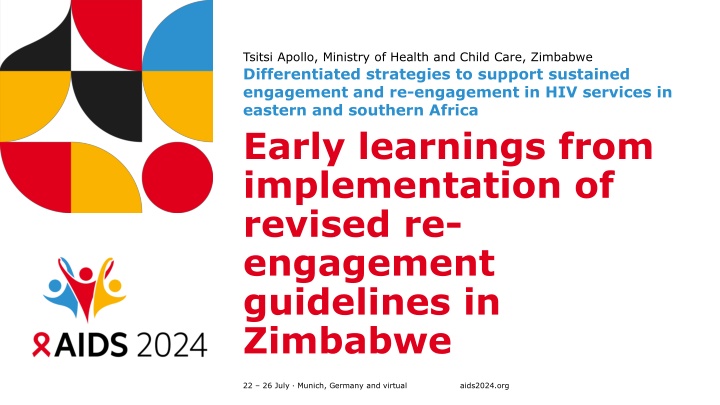
Innovative Strategies for HIV Care Re-engagement in Zimbabwe
Explore differentiated strategies implemented by the Ministry of Health and Child Care in Zimbabwe to support sustained engagement and re-engagement in HIV services. Learn about the updated Operational and Service Delivery Manual aimed at increasing retention in HIV care at all stages. Discover insights on re-engagement services, differentiated ART initiation, and integration of medical needs into service delivery models. Join the discussions at the upcoming event in Munich and online at aids2024.org.
Download Presentation

Please find below an Image/Link to download the presentation.
The content on the website is provided AS IS for your information and personal use only. It may not be sold, licensed, or shared on other websites without obtaining consent from the author. If you encounter any issues during the download, it is possible that the publisher has removed the file from their server.
You are allowed to download the files provided on this website for personal or commercial use, subject to the condition that they are used lawfully. All files are the property of their respective owners.
The content on the website is provided AS IS for your information and personal use only. It may not be sold, licensed, or shared on other websites without obtaining consent from the author.
E N D
Presentation Transcript
Tsitsi Apollo, Ministry of Health and Child Care, Zimbabwe Differentiated strategies to support sustained engagement and re-engagement in HIV services in eastern and southern Africa Early learnings from implementation of revised re- engagement guidelines in Zimbabwe 22 26 July Munich, Germany and virtual aids2024.org
Zimbabwes updated Operational and Service Delivery Manual The Ministry of Health and Child Care (MOHCC) updated its HIV Prevention, Testing and Treatment guidelines in 2022 in line with updated WHO guidelines the what to do , To accompany this, the Operational and Service Delivery Manual was updated - how to do it to increase retention at all steps of the cascade For doctors, clinical officers, nurses, counselors, pharmacists, health information officers, health promotion officers, community health workers and community-based organizations (CBOs) 22 26 July Munich, Germany and virtual aids2024.org
Whats in the OSDM on HIV care and treatment 1 2 3 4 Re-engagement in care Differentiated ART initiation Integration of other medical needs into DSD models for RoCs established on treatment SRH/HIV, DM and HPTN and mental health integration Differentiated service delivery for advanced HIV 22 26 July Munich, Germany and virtual aids2024.org
22 26 July Munich, Germany and virtual aids2024.org
Re-engagement in care Re-engagement services should ensure that RoCs who re-engage are received with dignity, are assisted and clinically managed and receive quality psychosocial services from healthcare workers. RoCs re-engaging in care are often those struggling the most with adherence and should not be penalized by being asked to attend more frequently unless there is a clinical indication. 22 26 July Munich, Germany and virtual aids2024.org
22 26 July Munich, Germany and virtual aids2024.org
Implementation experience from 70 facilities (1) Data on re-engagement (returning after 3+ months) from 70 public sector facilities from five provinces introducing new guidelines N=1,484 re-engaged between Oct 2022-Sept 2023 23% (n=345) received CD4 testing, 41% (n=142) had a CD4 cell count <200 cells/mL 14% (n=202) tested for TB-LAM, 12% (n=25) CrAG positive Dhiwayo R el al, Prioritizing advanced HIV disease screening for treatment interruption in PLHIV: early lessons from implementation of new guidelines in Zimbabwe , abstract 41000 22 26 July Munich, Germany and virtual aids2024.org
Implementation experience from 70 facilities (2) Health-care workers reported that guidelines specifying which laboratory test to prioritize for people living with HIV returning to care was helpful Client flow and staff shortages were challenges to implementation. Need to ensure that recipients of care get AHD screening on point of re-engagement Dhiwayo R el al, Prioritizing advanced HIV disease screening for treatment interruption in PLHIV: early lessons from implementation of new guidelines in Zimbabwe , abstract 41000 22 26 July Munich, Germany and virtual aids2024.org
Implementation experiences from 18 Facilities (3): Documented Urine TB-LAM and CrAg Tests among Patients Returning to Care with CD4 <200 cells/ml, 2023 56% (10/18) of facilities had documented patients eligible for TB LAM and CrAg Tests Eight HFs did not routinely offer a CD4 test or did not have patients with a CD4 test count below 200 copies/ml 5/10 and 4/10 of facilities conducted Urine TB-LAM and CrAg Tests respectively for all eligible patients. Urine TB-LAM coverage among eligible patients was 67% ranging from 14%- 100%. CrAg Testing coverage among eligible patients was 55% ranging from 0%-100%. MOHCC, HIV Quality of Care Assessment June 2024 22 26 July Munich, Germany and virtual aids2024.org
Implementation experience from 18 HFs facilities (4) Facilities with training in re-engagement guidelines confidently screened returning patients for Advanced HIV Disease (AHD). Newly initiating ART patients were more consistently offered CD4 tests compared to patients returning care Implementation was hindered by shortages of commodities such as Point-of-Care (POC) CD4 test kits and underutilization of conventional testing platforms. Some disengaged patients live in diaspora, sending others Malaicha to collect ARVs, missing out on AHD screening and management. 22 26 July Munich, Germany and virtual aids2024.org
Lessons Learnt: 1 2 3 4 Community Engagement and Support- Involving PLHIV and communities boosts program effectiveness Addressing Socio-economic determinants- Socio-economic barriers hinder care. Strategies like DREAMS reduce poverty and improve education Innovative Approaches- Technology bridges care gaps. Mobile apps, telemedicine and messaging enhance engagement and adherence Strengthening Health Systems- Health system investment is crucial. Improves infrastructure, supply chain chains, and healthcare financing for better care access 22 26 July Munich, Germany and virtual aids2024.org
Next steps Ensuring the consistent availability of essential commodities, such as CD4 test kits and other critical supplies through better forecasting, procurement, and distribution practices. Continuous professional development and mentorship programs, particularly for new staff, are essential to maintain high standards of care. Support people living with HIV to update the treatment literacy manual to incorporate re- engagement guidelines. Collaborate across borders to enhance the care for people living with HIV who are part of the diaspora. 22 26 July Munich, Germany and virtual aids2024.org
Acknowledgements MOHCC programme managers, health care workers National AIDS Council PEPFAR Global Fund UN Agencies Technical Partners Civil Society Organizations Recipients of Care IAS 22 26 July Munich, Germany and virtual aids2024.org






















